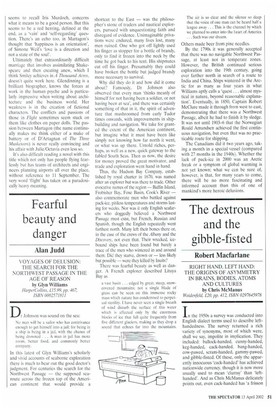Fearful beauty and danger
Man Judd
VOYAGES OF DELUSION: THE SEARCH FOR THE NORTHWEST PASSAGE IN THE AGE OF REASON by Glyn Williams
HarperCollins, £15.99, pp. 467, ISBN 0002571811
Dr Johnson was sound on the sea:
No man will be a sailor who has contrivance enough to get himself into a jail: for being in a ship is being in a jail, with the chance of being drowned . . . A man in jail has more room, better food, and commonly better company.
In this latest of Glyn Williams's scholarly and -vivid accounts of seaborne exploration there is much to bear out the good doctor's judgment. For centuries the search for the Northwest Passage — the supposed searoute across the frozen top of the American continent that would provide a
shortcut to the East — was the philosopher's stone of traders and nautical explorers, pursued with unquestioning faith and disregard of evidence, Unimaginable privations were endured, many lives lost, many men ruined. One who got off lightly used his finger as stopper for a bottle of brandy, only to find it frozen into the neck by the time he got back to his tent. His shipmates cut off his finger. Presumably they could have broken the bottle but judged brandy more necessary to survival.
Why did they do it and how did it come about? Famously, Dr Johnson also observed that every man 'thinks meanly of himself for not having been a soldier, or not having been at sea', and there was certainly something of that in it, the spirit of adventure that mushroomed from early Tudor times onwards, with improvements in shipbuilding and navigation. We take for granted the extent of the American continent, but imagine what it must have been like simply not knowing how far north it went, or what was up there. Untold riches, perhaps, as well as a new, quick gateway to the fabled South Seas. Then as now, the desire for money proved the great motivator, and trade and exploration went hand in hand.
Thus, the Hudson Bay Company, established by royal charter in 1670, was named after an explorer but was there to trade. Other evocative names of the region — Baffin Island, Frobisher Bay, Foxe Basin, Cook's River — also commemorate men who battled against pack-ice, pitiless temperatures and storms lasting for weeks. Nor was it only English seafarers who doggedly believed a Northwest Passage must exist, but French, Russian and Spanish, though the English repeatedly went farthest north. Many left their bones there or, in the case of the crews of the Albany and the Discovery, not even that. Their wrecked, icebound ships have been found but barely a trace of the men who wintered in and around them. Did they starve, drown or — less likely but possible — were they killed by Inuits?
There was fearful beauty as well as danger. A French explorer described Lituya Bay as
a vast basin . . edged by great, steep, snowcovered mountains; not a single blade of grass can be seen on this immense rocky mass which nature has condemned to perpetual sterility. I have never seen a single breath of wind disturb the surface of this water which is affected only by the enormous blocks of ice that fall quite frequently from five different glaciers, making as they drop a sound that echoes far into the mountains.
The air is so clear and the silence so deep that the voice of one man can be heard half a league away. . . This is the channel by which we planned to enter into the heart of America ... Such was our dream.
Others made beer from pine needles.
By the 1790s it was generally accepted that there was no navigable Northwest Passage, at least not in temperate zones. However, the British continued serious exploration into the 19th century, going ever farther north in search of a route to India and China, Ships wintered in the Arctic for as many as four years in what Williams aptly calls a 'quest . almost mystical in nature, beyond reasonable explanation'. Eventually, in 1850, Captain Robert McClure made it through from west to east, demonstrating that there was a Northwest Passage, albeit he had to finish it by sledge. It was not until 1903-6 that the Norwegian Roald Amundsen achieved the first continuous navigation, but even that was no practicable route for shipping.
The Canadians did it two years ago, taking a month in a special vessel (compared with 27 months in the 1940s). Whether the lack of pack-ice in 2000 was an Arctic freak or a symptom of global warming is not yet known; what we can be sure of, however, is that, for many years to come, there will be no more fascinating and informed account than this of one of mankind's more heroic delusions.


















































































 Previous page
Previous page